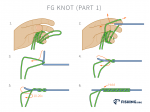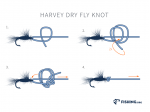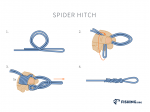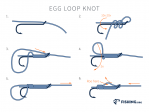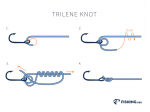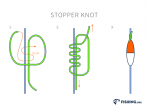Dropper Loop

How to Tie a Sturdy Dropper Loop Knot
For a dropper loop, it is one type of knot that has some ease in tying, and when you craft the rig yourself, you will be able to know your exact specifications. These include: the size of the knots you require, the distance between this type of knot and lastly the right number loops that you want for this exercise. If it happens that the loop tied is just too large for use, you can cut one side of the loop just at the point where it exits the knot. At this point, you need to ensure that it leaves a single strand that can provide a basis where the baits can be tied directly.
Step 2:
Step 3:
Our Take:
Fishermen and women everywhere use Dropper Loop Knots in their leader or tippet to add another attachment point for a second fly, additional bait, and jigs.
It lets you catch more than one fish at a time on a single monofilament or fluorocarbon fishing line. Depending on the length of the loop, you can set a hook directly on it.
If it is a large loop, you can cut one side of it just at the point where it exits the knot and leaves a single strand. This strand can provide a basis where you can tie an additional fly, live bait, or rubber worm directly.
Dropper Knots Can Help Knots From Slipping Out
The Dropper Knot is the easiest way to add multi-hooks to a fishing line. With some anglers struggling with knot slips, using this knot type can help.
When a knot slips off the hook or materials, get in the way, which causes the fishing experience to become less enjoyable for many anglers.
It is essential to know how to tie Dropper Loop Knots to help knots from slipping and to keep your fish on the line.
When to Use a Dropper Knot
If you are targeting the bottom of the water species by surf fishing or catching baitfish and panfish, this is when you should use the dropper loop knot. It lets you quickly switch hooks and weight sizes if fishing conditions change.
If you are fly-fishing in salt water and want to use two flies on the same line to catch two fish now, you can. You can even test one fly pattern against another with the Dropper Loop, making it the right knot choice.
Do not be surprised if the Dropper Loop Knot will become one of your favorites. Once you use it a few times, you might find it a challenge going back to single bait lines.
If you can change your flies and bait out quickly, based on changing conditions, you own the secret to catching more fish. It is also a great fishing tip to share with other anglers.
Dropper Knot Step-By-Step Instructions
Here are the 6 steps knot-tying instructions:
- Form a loop in the fishing line at your desired location.
- Pass that line from one side of the loop and move it all the way to the other side.
- Make five or more wraps and then keep the new loop in place and open.
- Push the bottom of the original loop up through the new opening and hold it with your teeth.
- Wet the knot with saliva and pull both ends in opposite directions.
- Pull the tag end evenly until wraps/coils tighten, and the loop stands out from the mainline.
Now, add your fishing tackle to your loop(s) and let the fishing adventure begin.
Conclusion
The more you practice using the Dropper Loop Knot, the better you will be at tying it. Gaining the ability to master the method will help enable you to make quality and sturdy knots.
Depending on your fishing style, location, and type, you can use alternative knots in this category, such as the Surgeon's Loop, Kreh, and Australian Plait knots. They, too, are reliable pro-fishing knot types like the Dropper Loop Knot.
 Carla Arbuckle
Carla Arbuckle 
